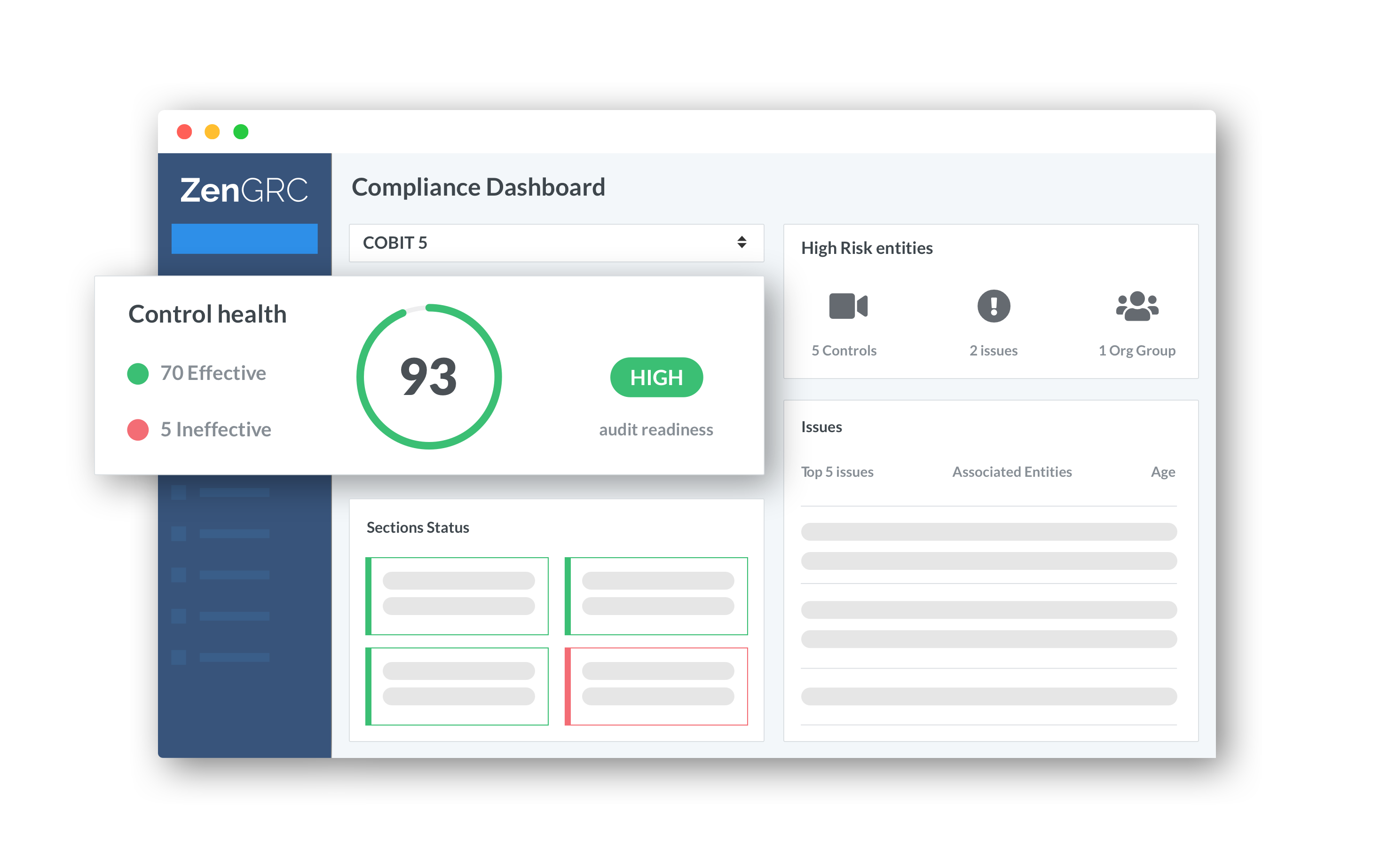COBIT Compliance Management Software
What Is COBIT Compliance?
COBIT is the acronym for Control Objectives for Information and Related Technologies, an IT governance framework used by organizations for implementing information systems and strategies. The COBIT Framework provides best practices and guidelines for managing IT processes to help businesses meet their goals. Using COBIT can improve compliance, risk management, and overall IT governance.
COBIT is an IT governance framework used by organizations for implementing information systems and strategies. It was created by the Information Systems Audit and Control Association (ISACA), which is a professional organization for IT audit professionals. The group wanted to develop a methodology that allows businesses to connect business goals to IT goals; COBIT is the result.
As an IT governance framework, COBIT guides how businesses implement, manage, and monitor their IT processes. This includes measurements, guidelines, and an outline that companies can use to help determine the effectiveness of their IT controls, so that your organization can comply with relevant regulatory requirements.
The COBIT framework also provides best practices for businesses to assure quality control and reliability in their information systems, two of the most important aspects of scaling a modern business.

Why Is COBIT Compliance Important?
The COBIT framework is important because it provides a common language that professionals can use to communicate their IT controls, business goals, and risk management objectives.
Without that common language, an organization undergoing an audit will have difficulty conveying the specifics behind its IT controls, which prolongs the audit and increases cost.
Moreover, non-compliance could lead to ineffective controls that don’t do a good enough job of preventing unauthorized access to information systems and sensitive data. So while COBIT is not a legal requirement, adopting it is still a good idea simply from a risk management perspective.
Without proper governance and risk management practices such as those outlined in COBIT, organizations face a significantly higher likelihood of financial damages due to stolen data, lost productivity, and harm to their reputation.
How can COBIT help you improve IT risk management?
COBIT provides a framework to identify, assess, and mitigate IT-related risks. For example, if your company collects large amounts of personal data, COBIT can help to identify the processes you have — or should have, at least — to keep that data secure.
By mapping IT processes to business objectives, organizations can pinpoint risks and the controls needed to manage them. (Such as more controls to keep personal data safe, rather than risking a breach.) COBIT’s risk management practices help businesses continuously monitor and improve risk handling.
This leads to the reduced chance and severity of adverse events. Overall, COBIT gives organizations the tools to build a robust IT risk management program aligned with business goals.
COBIT Compliance Audit Checklist
- Map out a strategic IT plan.
- Define your sensitive information architecture.
- Determine your IT goals and direction.
- Map out your IT infrastructure and relationships.
- Assess your risks and the severity level for each potential outcome.
- Determine the best path forward for your IT investment and management systems.
- Communicate your IT management goals and requirements to stakeholders and employees.
- Assure all controls appropriately map to your COBIT compliance requirements.
- Continuously monitor compliance objectives and control effectiveness.
Learn How to Align, Plan, and Organize for a COBIT Audit with Our 3-part Guide
COBIT Requirements at a Glance
Traditionally, new versions of the COBIT framework received increasing version numbers: COBIT 4 and COBIT 5, for example.
That ended with the most recent version of COBIT, which was released in late 2018 and named COBIT 2019. It focuses on cybersecurity, risk management, and corporate governance. Six COBIT principles are outlined in the most recent version, laying the foundation for COBIT compliance. They are:
- Provide stakeholder value
- Holistic approach
- Dynamic governance system
- Governance distinct from management
- Tailored to enterprise needs
- End-to-end governance system
Beyond that, COBIT’s core components are:

Framework

Control objectives

Management guidelines

Maturity models

Process descriptions
COBIT Compliance Made Easy with ZenGRC
Pre-Built Templates, Automated Audits, and Real-Time Monitoring to Ensure Compliance with COBIT
COBIT can help connect your enterprise IT goals and business processes and provide resources to build, monitor, and improve your compliance program. Still, this size cannot be managed with human resources and spreadsheets alone.
ZenGRC presents the COBIT framework in a format you can grasp. Its dashboard shows where your IT systems already comply and where they don’t, along with contextual insight so you can fill in the gaps. Then, when you’re ready, ZenGRC makes self-auditing a breeze so you can validate your own compliance measures.
ZenGRC COBIT Capabilities
- User-friendly dashboard with real-time metrics on prioritized risks
- Pre-built evidence request templates can help you with your compliance audits
- A central repository for COBIT compliance documentation
- Cross-control framework mapping for ISO/IEC, COSO, SOX, GDPR, NIST, and more
- Complete risk management functionality for assessments, scoring, and treatment throughout the risk lifecycle
- Interconnectivity among threats, vulnerabilities, risks, and controls for greater insight and monitoring

FAQs for COBIT Compliance
What is an IT governance framework?
An IT governance framework outlines a business’s methods to implement, manage, and monitor its IT governance. It defines the guidelines for measuring IT processes and provides a roadmap to evaluate the effectiveness of IT governance strategies. Such frameworks are most commonly used to facilitate compliance with legal and regulatory requirements regarding IT.
How long has COBIT been around?
COBIT was first released in 1996 to help organizations of all sizes and industries govern and manage their information and technology.
Initially, COBIT was designed solely for IT auditors. COBIT 2 was released in 1998 and provided additional guidance on IT controls.
COBIT 3 emerged in 2000 as a management framework, incorporating IT management and information governance techniques.
COBIT 4 was released in 2005 as a full-fledged IT governance framework. In 2007, COBIT 4.1 added more governance regarding information and communication technology. In 2012 COBIT 5 was launched as a comprehensive framework of “globally accepted practices, analytical tools, and models, and included enhancements to facilitate the alignment of overall enterprise strategy with IT strategy.”
The most recent version is COBIT 2019, which streamlined updates to the framework and implemented greater flexibility with changing technology. COBIT 2019 also includes a maturity model based on the CMMI Capability Maturity Model Integration.
What’s the difference between COBIT and ITIL?
COBIT is more concerned with the “what” of an organization and how it runs, whereas ITIL is more concerned with the “how.” Since COBIT focuses on things from a business goal perspective, it makes the rules and helps to govern what kinds of processes should be in place to achieve those goals.
In contrast, the Information Technology Infrastructure Library (ITIL) is a set of best practices for IT service management, focusing on aligning IT services with business needs. It is mostly concerned with making IT work. It receives directives from management but then uses its own toolkit to implement the processes and services.
What are the practical applications of COBIT 2019?
The practical applications of COBIT 2019 include:
- Risk management
- Information security
- Business continuity
- Regulatory compliance
- Quality assurance
What is the difference between NIST and COBIT?
The National Institute of Standards and Technology (NIST) provides a cybersecurity framework centered around identifying, protecting, detecting, responding to, and recovering from cyber threats. COBIT provides a broader IT governance framework that aligns IT with business goals. While NIST is security-focused, COBIT covers end-to-end IT management and governance. So the COBIT and NIST frameworks complement each other, but they are not the same.
Which industries commonly use COBIT?
COBIT is broad enough to apply to any industry but is especially common in highly regulated sectors such as finance, healthcare, energy, and government. Industries handling sensitive data use COBIT to improve security, privacy, and compliance with IT governance and risk management regulations.
